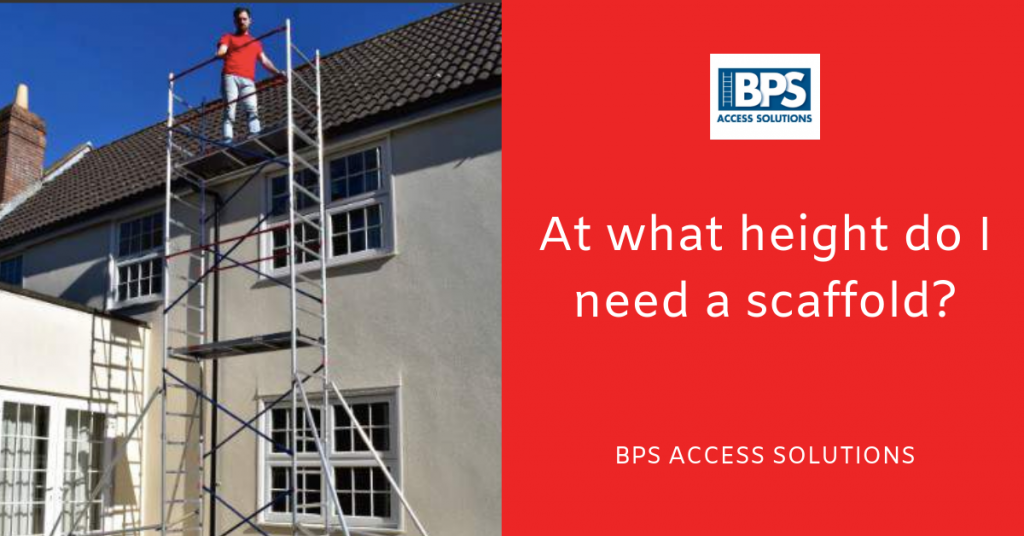At what height do I need a scaffold?
Although simple to use and easy to erect, one of the main drawbacks of ladders is their instability at height. Working on a standard ladder, even with additional support, becomes risky once extending above a few metres.
Some types of ladder, for example the step ladder, are unsuitable for use at even lower heights, as they are simply not designed with adequate safety features. Weight capacity can also be a problem as it can restrict usage to light, one handed tools when working on standard ladders.
So where do you draw the line between using a ladder and using some form of scaffold? Below we’ll discuss the various considerations, such as work environment and the type of task being carried out, that you should be taking into account when choosing between a ladder and scaffolding.
Your work site
All work sites are different, varying from day to day depending on the weather and the progress of ongoing projects. The main variation you need to consider when choosing scaffolding is whether the work you will be carrying out is indoors, outdoors or even a combination of the two.
Indoors
Generally an indoor work site is more predictable than an outdoor work site. Working surfaces indoors are much easier to prepare for all manner of tasks and tools. Additionally, unless work is being carried out on an especially high-ceilinged space, the need for high access equipment is minimal.
For indoor work at a minimal height, a step ladder will often be enough to get the job done. However, a step ladder will have a limiting effect on the user’s reach and ability to use heavier tools.
When working on a flat, smooth surface, one of the most popular forms of indoor scaffolding is the rolling scaffold. With wheels attached to the bottom of each leg, rolling scaffolds offer unrivalled mobility and ease of use indoors.
A key consideration to bear in mind before using a rolling scaffold is ensuring the wheels are locked in place using the castors attached. If the wheels are not locked, the scaffold will not remain still when in use, which greatly increases the risk of injury.
In terms of height, the general rule of thumb is that scaffolding should be no more than four times the height of the shortest side of the scaffold’s base, without being tied or attached to another structure. For example, if a scaffold tower’s base measures 2.5m by 3.0m, the maximum height the scaffold should be extended to without additional fastening is 10m.
Precautions like these are very important when working at height, as a simple slip could easily result in serious injury or death.
Outdoors
Ground conditions outdoors are rarely as consistent or predictable as ground conditions in an enclosed space. Outside factors such as weather and unfinished surfaces can result in hazardous working conditions, meaning more care is required when setting up a scaffolding tower.
One advantage of setting up tower scaffolding outdoors is the fact that there are usually more external objects you can secure the structure to. Not only do buildings, constructed or under construction, provide a solid footing against which to fasten scaffolding, the available space for scaffolding outdoors is usually much larger.
This generally allows a scaffolding structure to be built much taller than it would be indoors, but this also comes with a need for additional safety precautions. Rolling scaffolds are generally less suitable for use outdoors because of inconsistent ground conditions. If rolling scaffolding is all that is available, additional stabilisers can be attached around the base to provide added stability when working at height.
When taking into account the guidelines for base area in relation to total scaffold tower height, these additional stabilisers can be counted as a wider base area. This means that when stabilisers are added on each corner of the standard frame, the new base dimensions will be measured from their points of contact with the ground. The new maximum height limit without attachments to another structure would now be measured using the smallest side of the base including stabilisers.
Generally, static scaffolding systems are more suitable for outdoor use due to the added stability and rigidity they provide. Scaffolding systems which rest upon mudsills with adjustable base plates are the best option for slightly uneven outdoor surfaces. Base plates allow the weight of the scaffold tower to be spread over a greater surface area, whilst allowing individual uprights to be adjusted independently.
Suspended scaffolds
Even when attached to another structure with fastenings, additional scaffold tower height will still increase the risk of accident to users.
In cases where work needs to be carried out at considerable height, suspended scaffolding systems can be a useful alternative to conventional scaffolding. Suspended scaffolds rely on a variety of fastening systems attached to the top of the main building structure. A working platform is then lowered from the top-down, allowing work to be carried out at even greater height than is achievable with normal bottom-up scaffold towers.
Suspended scaffolding cranes can be installed permanently on the top of buildings for use in tasks such as window cleaning. They can also be installed temporarily to give access to the side of a building structure at height.
The main benefit of using a suspended scaffold system is the ability to carry out work on the side of a building in cases where the ground surface is not stable enough to support conventional scaffold towers. At lower heights the use of this type of structure may not be worth the extra time and cost of installation because the same end result can be achieved with a simpler scaffold system.
To find out more about the full range of scaffolding solutions we provide, please get in contact today.
No related posts.



